1860 – 1888
In 1819, the very first Atlantic crossing was made with a ship powered by steam. Of course, the 320-tonner Savannah with her 110 feet (34 m) wasn’t entirely driven by steam. As often as the crew could, they would use the sails. But these early steamers weren’t seen as passenger ships. Being a passenger on a ship sailing such a vast distance up until then was neither common, nor pleasant. The ships were designed for cargo so there were not much space left for passengers. But a few decades later, the great emigration from Europe to America required better accommodations for paying passengers. Now it wasn’t unusual that the ships earned more money on the passengers than on the cargo.
The first crossing with steam as the only power-resource was accomplished in 1837 by the paddle steamer Sirius. This showed that a new era was about to begin in shipping history. All this fascinated the English engineer Isambard Kingdom Brunel. He started to work on a project that would end up in the revolutionary 3,270-tonner Great Britain. Her hull was all iron and she had a strength of one thousand horsepowers in her four cylinder engines. Her hull was divided into several watertight compartments with strong bulkheads to restrain possible pressure of water. Her tonnage combined with her length of 289 feet (87 m) made her the largest ship in the world.
But still being aboard her wasn’t actually as being inside a hotel, and that was the feeling that shipbuilders of the time wanted to create. Brunel wasn’t satisfied either, and started to work on what was going to be the most misplaced ocean liner in history.
On November 7, 1857 an attempt to launch the 19,000-tonner Great Eastern was made (still she was called the Leviathan). Being six times larger than any ship ever built; she had to be launched sideways. But the Great Eastern only wanted to move some three feet and then she stopped and refused to go any further. Almost three months went by until she was pushed into the sea, but on January 30, 1858 the colossus was at last afloat. The long launch had pushed the price high above the expected, and there was no money to continue the work on Great Eastern. She laid about a year in the same place without anyone doing anything to finish her.
The reason why the Great Eastern was so extremely large was that she was built for the run from Europe to Australia. Earlier steamers had to refuel in almost every harbour they passed. The Great Eastern was designed to make the entire trip without refuelling until she reached Calcutta. Also, it wasn’t a coincidence that Great Eastern had the length she had (689 feet, 211 m). A problem that had haunted captains and passengers throughout the times of seafaring was that a ship ‘rolled’ because of the great waves hitting the hull. When the Great Eastern was constructed it was made sure that she was longer than any wave ever measured. Even though this precaution was taken the Great Eastern would become famous for her vomit-causing rolling.
During the time the Great Eastern lay undisturbed, her maker, Brunel had given up the thoughts about her going to Australia, in favour of the transatlantic run. Great Eastern was bought by the Great Ship Company and they completed her in August 1859. Brunel missed her sea trials, perhaps luckily for him because on September 9, a terrible explosion caused by a stuffed ventilator tore the upper deck up, and the foremost funnel was launched like a rocket. Scalded men came from the ship’s inside, one of them throwing himself over the side and was mangled to death by the blade wheels. Brunel, who had received a stroke when missing Great Eastern’s sea trials, received another one when he heard about the news, and died on September 15.
The Great Eastern’s maiden voyage was on June 17, 1860, and her goal was New York, America. When arriving, she received a fourteen cannon salute. She was the first merchant ship to ever receive such an honour. Unfortunately, she had sailed almost empty, and to make just some more money she was opened up for the public, and she had over 150,000 people visiting her in July. Two two-day cruises were organised for ten dollars per person. The first one attracted over 2,000 people, and since no one had expected such an interest, only 200 berths had been made ready, food was inadequate for the extra 1,800 persons and the rest of the ship was dirty. As a result from that, the second cruise only attracted approximately one hundred people. These figures are extremely small when you know that the Great Eastern had room for over 4,000 passengers. (Even the Queen Mary from 1936 failed to exceed that number, with a tonnage of 81,000.)
The Great Eastern continued to be haunted by bad luck, and she never carried a full complement of passengers. Her third voyage she made in eight and a quarter of a day, a record for her, but not enough to receive the Blue Riband, though. On her fourth voyage over the Atlantic, a storm caught up with her and she broke her rudder and was totally left without any help in the storm. It lasted for three days and during that time had the ship been thrown back and forth at 45º angles. After an emergency rudder had replaced the broken one, the Great Eastern slowly approached Cork, Ireland, where the repairs took eight months and cost £60,000.
In August 1862, the Great Eastern sailed with her record of paying passengers; 1500. But the bad luck wasn’t far away. When she crossed an uncharted area, she tore up a gash in her bottom measuring 75 feet long and 4 feet wide. She stayed afloat thanks to her double bottom. The Great Eastern continued to lose money, and she was considered too uneconomical by her owners, and eventually she was taken out of service.
In 1865 the second transatlantic cable was to be laid out (the first had broken only after three weeks, and now a more trustworthy and solid one was required), and no ship in the world was big enough to carry this enormous cable. No ship but the Great Eastern. She was chartered by the Atlantic Telegraph Company. Large areas of her luxurious interior were taken out to accommodate the big cable. She started her mission from Ireland, but after half the way, the cable broke and was lost in 6,000 feet of water. But shame on those who give up. The next year the Great Eastern tried again, and this time ended up in success. On her way back, the Great Eastern found and picked up the previous cable, and when she returned she had accomplished her mission and was still in possession of an excellent cable. After this she was turned into a passenger vessel again, but that proved a failure. In 1869 the French government chartered her to lay another transatlantic cable. This was probably the only thing she was allowed to do, because as a cable laying ship she was a success. But in 1874 a ship specially designed to handle cable laying was launched; the Faraday. The Great Eastern was outdated. For twelve years she lay rusting in Milford Haven, only to be bought by Edward de Mattos in 1885 for only 26,000 pounds. He used her as a floating advertising board. In 1888 she was sold to a scrapping firm for 16,000 pounds. It is often said that when taking her apart, a skeleton was discovered inside her double bottom; one of the workers that had built the ship in the 1850s. Was it he that had cursed the Great Eastern when he realised that no one could hear him or let him out? Although the story is most likely a myth, one can’t help but wonder if such a tragic tale could have explained the misfortunes of the Great Eastern.
Specifications
- 689 feet (211 m) long
- 117.9 feet (36 m) wide
- 18,915 gross tons
- 6,500 square yards of sail, one propeller and two paddle wheels
- 14 knot service speed

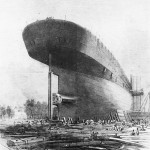
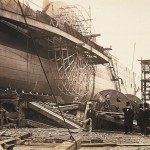
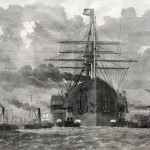
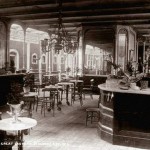
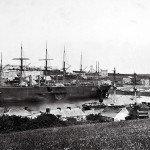

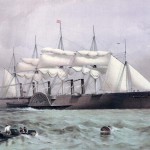
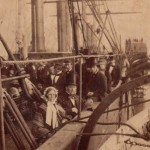
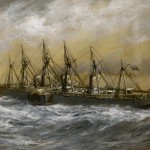
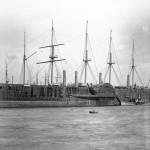
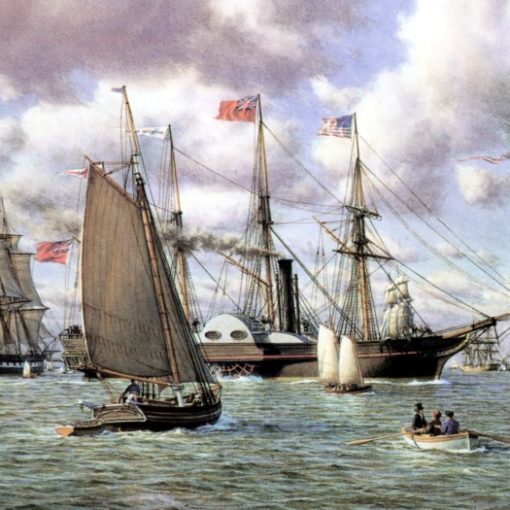
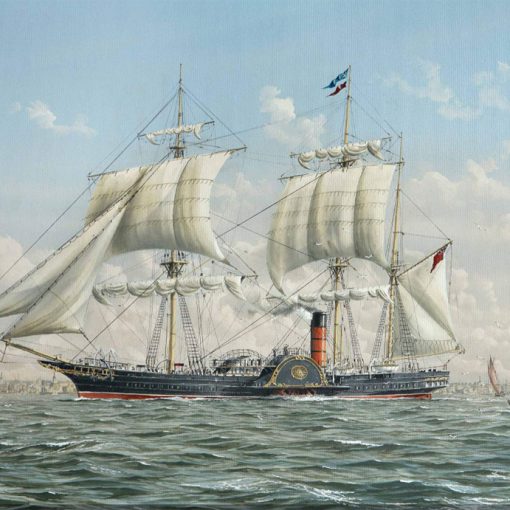
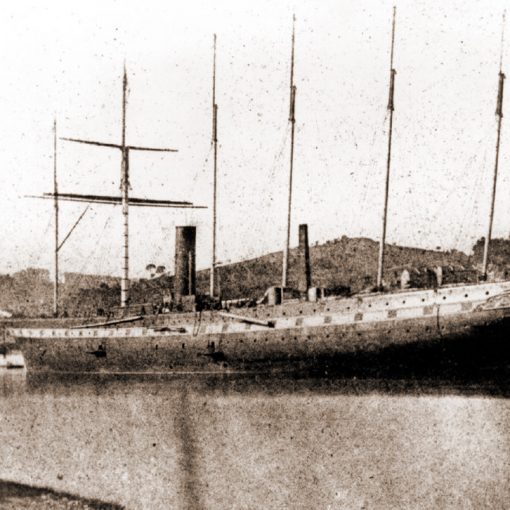
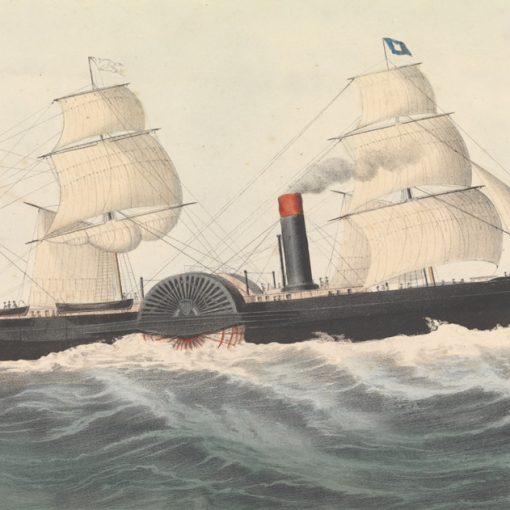
2 thoughts on “Great Eastern”
Fantastic, having follow and used info from your first webpage, back in 2000…I most sat this truly amazing.
Thank you, Christian, for your kind words. And congrats on being the very first to submit a comment on our new website! Thanks for giving this new feature a proper field test. 🙂